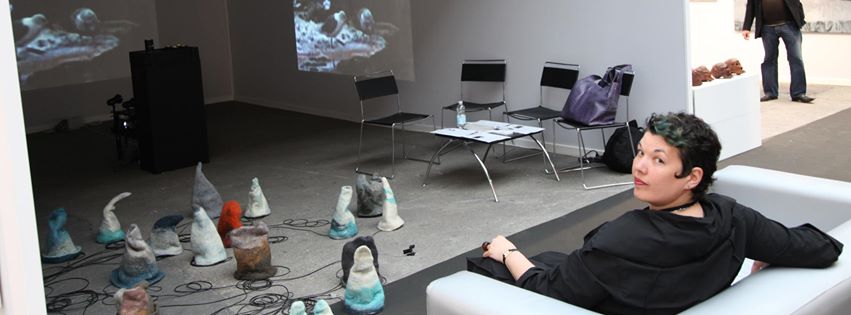Outside the service entrance of the Cultural Flow Zone at Ca’Foscari Zattere, on an old wooden dock overlooking the canals, the team behind one of the preeminent satellite exhibitions on view now in conjunction with the 56th Venice Biennale takes the occasional cigarette break or stops to relax for a moment in the sunshine. Inside the Cultural Flow Zone, contemporary New Media art, digital video, and performative installations are carefully arranged in conversation with 20th century Russian paintings from the Arfiev group. With the exhibition On My Way finally open to the public after weeks of preparation and a glittering opening, co-curator and participating artist Anna Frants sat down to answer some questions about her own artistic practice, her career as a curator and running one of the Russia’s most significant New Media non-profits.
As an artist, Anna Frants’ interactive installations have been exhibited at The St Petersburg Biennial, The Moscow Biennial, and The Polish Biennial, as well as The KuoseinoSato Museum of Contemporary Art (Fukuoka, Japan), The Museum of Art and Design (New York, USA), The State Hermitage Museum (St Petersburg, Russia), The Chelsea Art Museum (New York, USA), and Transmediale (Berlin, Germany).
In addition to her artistic accomplishments, Frants is also a distinguished curator active in the expanding international field of New Media and co-founder of CYLAND, a nonprofit that organizes an annual new media festival held in St Petersburg, Berlin, Tokyo and New York and houses Eastern Europe’s largest video archive as well as an artist residency program. I stole a few moments of the hard-working curator’s time in between mad dashes to through the exhibition and interviews with the BBC for a brief conversation about art, curating, Venice, and advice.
INTERVIEW WITH CURATOR ANNA FRANTS
Chased Magazine: How did you get started as an artist and a curator?
Anna Frants: I began as an artist — I wanted to to be an artist for as long as I can remember. I was trained as an artist and work professionally in the studio before I ever started curating. In fact, I began curating, because I just wanted things go right. In a modern world, I think, those two positions go hand in hand.
CM: How would you describe your artistic practice?
AF: I have background in industrial design, computer animation and video—I firmly believe that new technologies from livecams to Ardiuno computerscan help express aesthetic and conceptual ideas in a new way, however at the end of the day any technology we employ is in the service of art, and not the other way around.
CM: How do you balance working as an artist and a curator?
AF: It comes together naturally; however when working on my personal projects in the studio, I always make sure to shut off my phone and log off of Skype.
CM: Where do you go for inspiration?
AF: For me,walking around New York City is best inspiration.
CM: How do you go about curating an exhibition? Where do you start? What do you focus your attention on?
AF: I usually start with a basic concept and a consideration of the space. Since I am dealing with multimedia work when I curate, it is very important to have a thorough understanding of the space before settling on select artworks for inclusion otherwise you may end up with artworks that cannot be exhibited properly due to lighting conditions or space considerations.
CM: What made you decide to host an exhibition in Venice at the Biennale?
AF: The Venice Biennale is a non-commercial venue which makes it more attractive than the traditional commercial spaces, which struggle with the difficulties in collecting, preserving, and exhibiting New Media and Cyberart. As a boundary-pushing showcase of contemporary art, the Venice Biennale suits CYLAND’s mission, and offers CYLAND’s artists great exposure.
CM: How do you go about hosting an exhibition in Venice? What are some of the more unusual or unexpected elements that go into putting on a show here?
AF: This is the third year that we’ve participated in the Venice Biennale, and to my complete delight this year there were no surprises.
CM: How do you find time to work on your own practice with all of the pressures of running a business and curating exhibitions on a global scale?
AF: Planning is the key.
CM: Do you have any advice for young artists, curators, or entrepreneurs out there?
AF: I would offer young creatives the advice that was first given to me by a teacher when I arrived at Pratt to study animation: “Do not go into art world if you are not sure that you will be devoted to it. Once you take it easy for a moment another person will take your place.”
Interview by Hannah Nelson-Teutsch, in collaboration with CYLAND Media Art Lab



